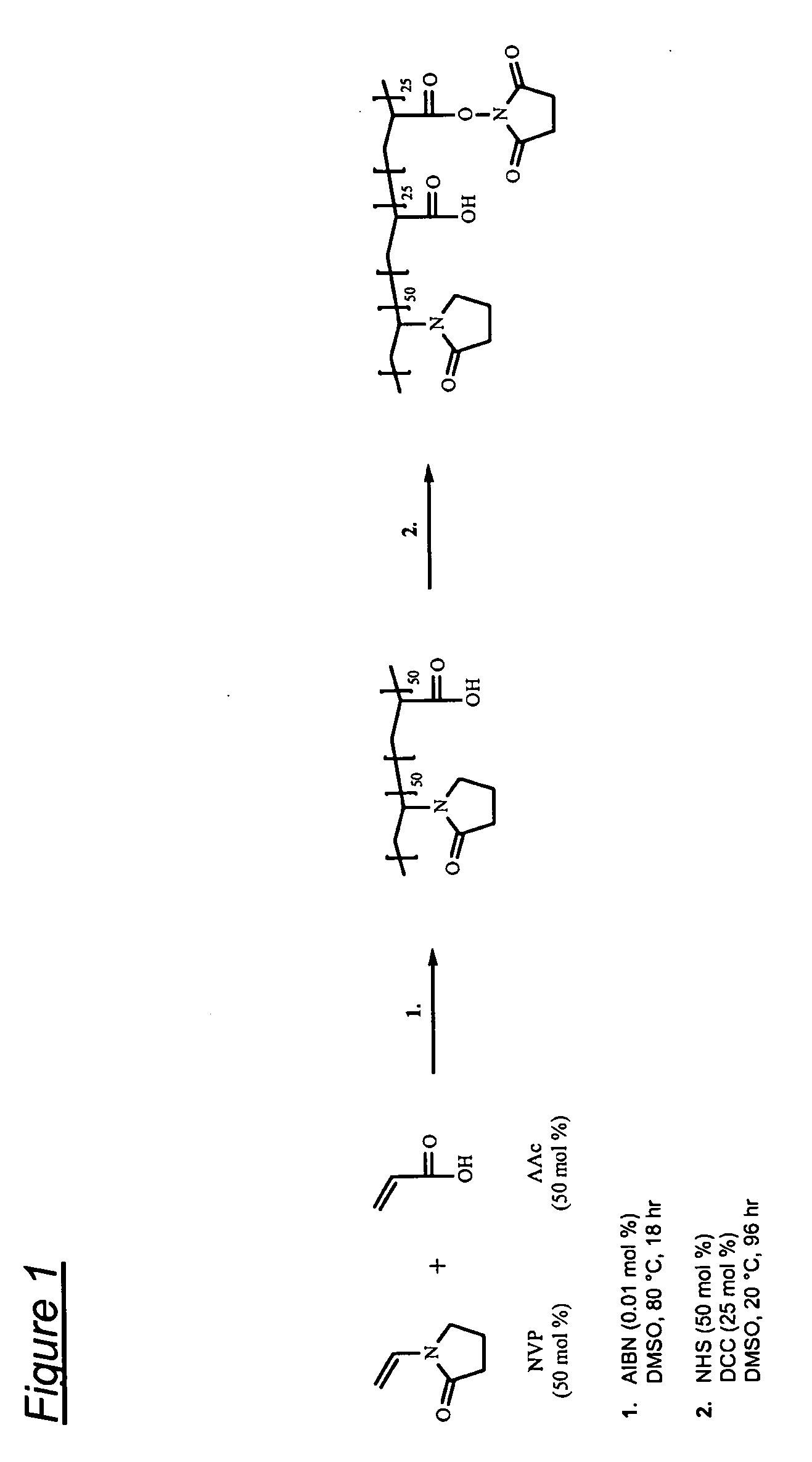Coated medical devices
a medical device and coating technology, applied in the field of coating medical devices, can solve the problems of high adhesion between the device and the tissue surface, and achieve the effects of enhancing cellular infiltration/ingrowth and tissue integration, facilitating tension-free implant and repair, and reducing the risk of migration
- Summary
- Abstract
- Description
- Claims
- Application Information
AI Technical Summary
Benefits of technology
Problems solved by technology
Method used
Image
Examples
example 1
Synthesis of poly(VP50-AAc25-AAc(NHS)25) terpolymer
[0096]The reaction is shown schematically in FIG. 1.
[0097]2000 ml of deoxygenated DMSO is heated to 80° C. 121.3 g (1.09 moles) of NVP and 78.7 g (1.09 moles) of AAc are added to the DMSO followed by 0.04 g (2.44×10−4 moles) of AIBN. The reaction is left at 80° C. for 17-19 hours and then allowed to cool to room temperature. 125.6 g (1.09 moles) of NHS is dissolved in the polymer solution followed by the addition of 112.6 g (0.545 moles) of DCC dissolved in 225 ml of DMF. The reaction is left stirring at room temperature for 96 hours. The reaction by-product, DCU, is removed by filtration under reduced pressure using a sintered glass filter. The polymer is isolated by mixing with 2000 ml of IPA followed by precipitation from 13000 ml of diethyl ether followed by filtration. The polymer is washed three times in 2500 ml of diethyl ether and then dried at 40° C. under reduced pressure.
[0098]The polymer is purified further to remove tra...
example 2
Characterisation of poly(VP-AAc-AAc(NHS)) terpolymer
[0100]It is found that the molecular weight of the product of Example 1 is dependent on the duration of the Soxhlet extraction. This in turn affects the viscosity of the product. Table 1 illustrates the dependence of molecular weight and viscosity of the polymer on the duration of the Soxhlet extraction performed in Example 1.
[0101]The measurements were performed as follows:
Molecular Weight Analysis
[0102]The samples were analysed in duplicate by GPC in DMF solvent containing 0.1% LiBr. The system was calibrated using PEG / PEO standards. System details were:
Polymer Laboratories LC1150 HPLC Pump
Viscotek TDA Model 300, Column Oven and Refractive Index Detector
[0103]Polymer Laboratories PLGel Mixed B column, with guard column
Temperature 70° C.
[0104]Flow Rate 1.0 mL / min
Viscosity Test
[0105]This procedure is used to determine the relative viscosity of a solution of the polymer product of Example 1. The procedure is based on flow times thro...
example 3
Application of poly(VP-AAc-AAc(NHS)) terpolymer to Small Intestine Submuccosa (SIS)
[0107]SIS is an extracellular matrix comprising collagen, non-collagenous proteins and other biomolecules.
3.1 Assessment of Application / Coating Method and Handling Characteristics
SIS
[0108]Poly(VP50-AAc25-AAc(NHS)25) terpolymer prepared according to Example 1 Methylene Blue
Dichloromethane / methanol (DCM / MeOH) 15:4 v / v
[0109]A solution of terpolymer was prepared at 10% w / v in the 15 / 4 solvent mix, incorporating a maximum of 0.025% w / v methylene blue. The terpolymer solution was applied to SIS using K-bars to give the following approximate coat weights: 10 mg / cm2, 15 mg / cm2, 20 mg / cm2 and 30 mg / cm2.
[0110]At all four coat weights the terpolymer solution coated down smoothly and evenly onto the SIS graft, but tended to accumulate within the ridges. The product was dried under vacuum for 24 hours at 20° C. to remove solvent residues. The terpolymer solution did not seep through the graft to the reverse side.
[...
PUM
| Property | Measurement | Unit |
|---|---|---|
| temperature | aaaaa | aaaaa |
| temperature | aaaaa | aaaaa |
| depth | aaaaa | aaaaa |
Abstract
Description
Claims
Application Information
 Login to View More
Login to View More - R&D
- Intellectual Property
- Life Sciences
- Materials
- Tech Scout
- Unparalleled Data Quality
- Higher Quality Content
- 60% Fewer Hallucinations
Browse by: Latest US Patents, China's latest patents, Technical Efficacy Thesaurus, Application Domain, Technology Topic, Popular Technical Reports.
© 2025 PatSnap. All rights reserved.Legal|Privacy policy|Modern Slavery Act Transparency Statement|Sitemap|About US| Contact US: help@patsnap.com


